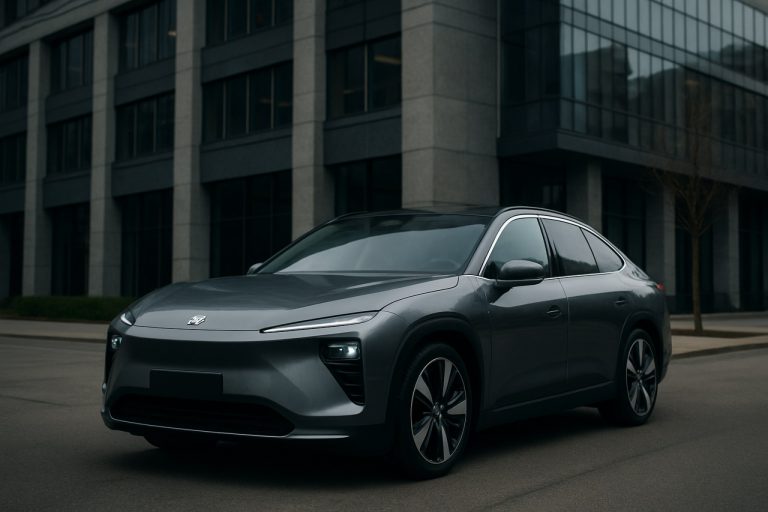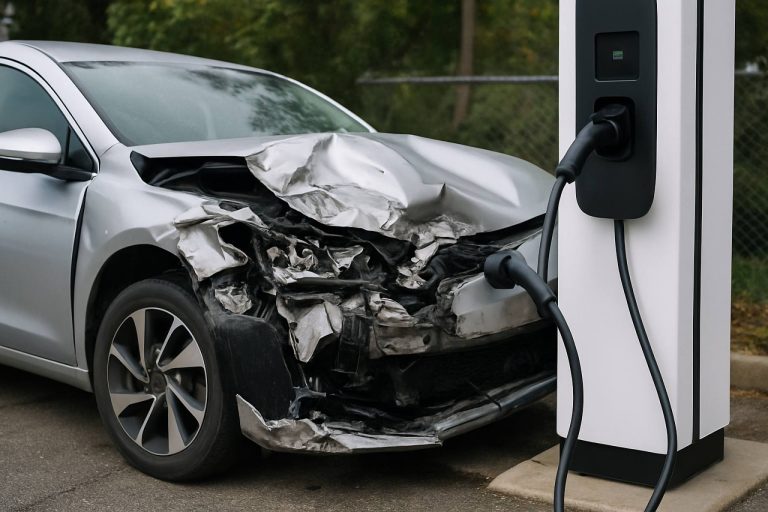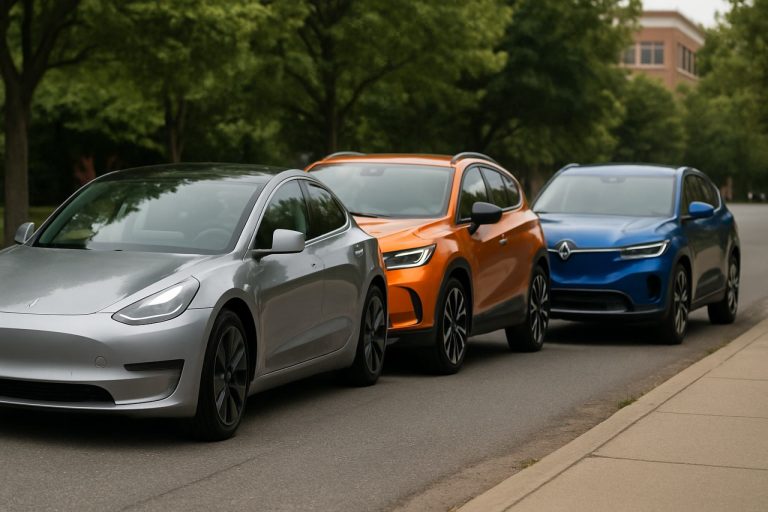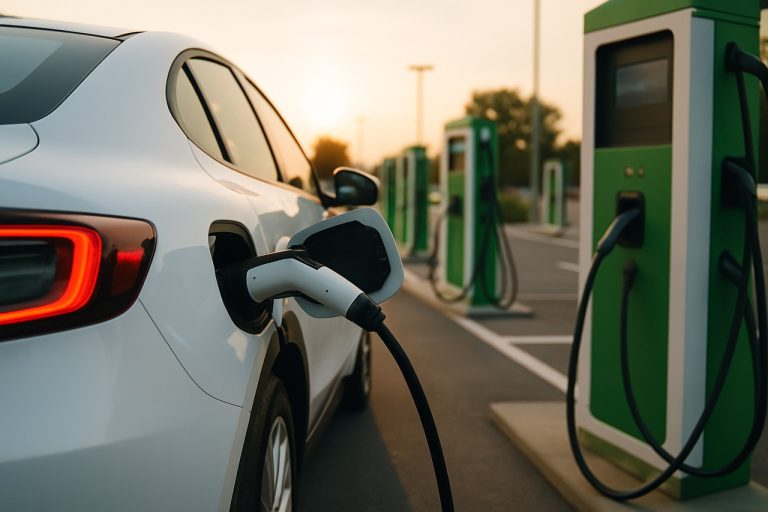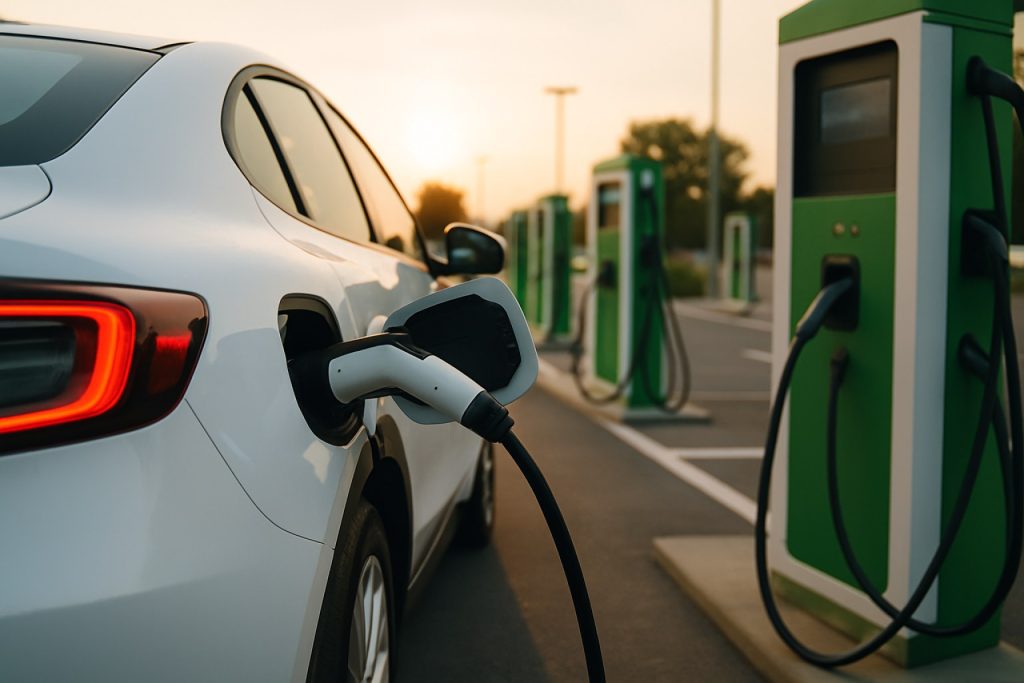
EV Charging Infrastructure in 2025: Unprecedented Expansion, Smart Technology, and the Race to Meet Surging Demand. How the Next Five Years Will Reshape the Electric Mobility Landscape.
- Executive Summary: Key Trends and Market Drivers
- Global Market Size and 2025–2030 Growth Forecasts
- Competitive Landscape: Leading Players and New Entrants
- Government Policies, Incentives, and Regulatory Frameworks
- Technological Innovations: Ultra-Fast Charging, V2G, and Smart Grids
- Deployment Models: Public, Private, and Fleet Charging Solutions
- Grid Integration and Renewable Energy Synergies
- User Experience: Payment Systems, Interoperability, and Accessibility
- Challenges: Infrastructure Gaps, Urban vs. Rural Rollout, and Cybersecurity
- Future Outlook: Strategic Opportunities and Industry Roadmap
- Sources & References
Executive Summary: Key Trends and Market Drivers
The global EV charging infrastructure sector is experiencing rapid expansion in 2025, driven by surging electric vehicle (EV) adoption, ambitious government policies, and significant investments from both public and private stakeholders. The number of public charging points worldwide surpassed 3 million in 2024, with projections indicating continued double-digit annual growth through the next several years. This expansion is underpinned by a combination of regulatory mandates, automaker commitments, and technological advancements.
Key market drivers include stringent emissions targets and electrification mandates in major automotive markets such as the European Union, China, and the United States. The European Union’s Alternative Fuels Infrastructure Regulation (AFIR) requires member states to deploy fast-charging stations at regular intervals along major transport corridors, accelerating infrastructure rollout. In the United States, the National Electric Vehicle Infrastructure (NEVI) Formula Program is channeling billions of dollars into the buildout of a nationwide fast-charging network, with a focus on interoperability and reliability.
Private sector investment is also intensifying. Major automakers are forming alliances to develop proprietary charging networks and improve user experience. For example, BMW Group, Mercedes-Benz Group, Ford Motor Company, General Motors, Honda Motor Co., Hyundai Motor Company, Kia Corporation, and Stellantis N.V. have announced a joint venture to deploy at least 30,000 high-powered charging points across North America by 2030. Meanwhile, established charging network operators such as Tesla, Inc. (with its Supercharger network), IONITY GmbH (a joint venture of major European automakers), and BP p.l.c. (through its bp pulse division) are scaling up their networks and opening them to a wider range of EV brands.
- Ultra-fast charging (150 kW and above) is becoming the new standard, reducing charging times and supporting long-distance travel.
- Interoperability and open access are key trends, with roaming agreements and standardized payment systems gaining traction.
- Integration with renewable energy and smart grid technologies is advancing, supporting grid stability and decarbonization goals.
Looking ahead, the EV charging infrastructure market is expected to remain a critical enabler of the broader transition to electric mobility. Continued policy support, cross-industry collaboration, and innovation in charging technology will be essential to meet the needs of a rapidly growing EV fleet through 2025 and beyond.
Global Market Size and 2025–2030 Growth Forecasts
The global electric vehicle (EV) charging infrastructure market is poised for significant expansion between 2025 and 2030, driven by accelerating EV adoption, government mandates, and substantial investments from both public and private sectors. As of 2025, the number of public charging points worldwide is expected to surpass 5 million, with the largest concentrations in China, Europe, and the United States. This growth is underpinned by ambitious national targets and the rapid electrification of transport fleets.
China remains the world leader in EV charging infrastructure, accounting for more than half of all public charging stations globally. The country’s state-backed initiatives, such as the “New Energy Vehicle Industry Development Plan,” continue to drive the deployment of both fast and slow chargers. Major Chinese companies like State Grid Corporation of China and TELD are expanding their networks aggressively, with State Grid alone operating hundreds of thousands of charging points.
In Europe, the European Union’s Alternative Fuels Infrastructure Regulation (AFIR) is set to accelerate the rollout of high-power charging corridors along major highways by 2025. Leading European charging network operators, including IONITY (a joint venture of BMW, Ford, Hyundai, Mercedes-Benz, and Volkswagen Group), are investing in ultra-fast charging stations to support long-distance travel and meet the growing demand from new EV models.
The United States is also witnessing rapid infrastructure growth, spurred by federal funding through the National Electric Vehicle Infrastructure (NEVI) Formula Program. Companies such as Tesla, Inc. (with its Supercharger network), ChargePoint Holdings, Inc., and EVgo, Inc. are expanding their footprints, with Tesla opening its Supercharger network to non-Tesla vehicles in select locations to further accelerate adoption.
Looking ahead to 2030, the global EV charging infrastructure market is projected to grow at a compound annual growth rate (CAGR) exceeding 25%. By the end of the decade, the total number of public charging points is expected to reach 20–25 million, with a marked shift toward high-power DC fast charging to accommodate larger EV fleets and commercial vehicles. The integration of smart charging, vehicle-to-grid (V2G) technologies, and renewable energy sources will further shape the market landscape, as major players and new entrants compete to provide reliable, accessible, and sustainable charging solutions worldwide.
Competitive Landscape: Leading Players and New Entrants
The competitive landscape of the EV charging infrastructure sector in 2025 is characterized by rapid expansion, strategic partnerships, and technological innovation. The market is led by a mix of established global players, regional champions, and a growing cohort of new entrants, all vying to capture a share of the accelerating demand for electric vehicle (EV) charging solutions.
Among the global leaders, Tesla, Inc. continues to expand its proprietary Supercharger network, which now includes thousands of high-speed charging stations across North America, Europe, and Asia. In 2024, Tesla began opening its Supercharger network to non-Tesla vehicles in select markets, signaling a shift toward greater interoperability and network utilization. Tesla, Inc. also invests in ultra-fast charging technology and integrated payment solutions, reinforcing its position as both a vehicle manufacturer and infrastructure provider.
Another major player, ABB Ltd, is a global supplier of DC fast charging equipment and digital charging management platforms. ABB’s Terra series chargers are widely deployed in public, commercial, and fleet applications, and the company is actively involved in pilot projects for megawatt charging systems aimed at heavy-duty vehicles. ABB’s focus on modular, scalable solutions and its partnerships with utilities and automakers position it as a key enabler of large-scale charging rollouts.
In North America, ChargePoint Holdings, Inc. operates one of the continent’s largest open charging networks, with over 200,000 activated ports as of early 2025. ChargePoint’s business model emphasizes networked hardware, cloud-based management, and integration with fleet and workplace solutions. The company is expanding into DC fast charging and collaborating with automakers to streamline the user experience.
Europe’s landscape is shaped by companies like IONITY GmbH, a joint venture of major automakers including BMW, Ford, Hyundai, Mercedes-Benz, and Volkswagen Group. IONITY operates a high-power charging network along major highways, supporting long-distance EV travel with 350 kW chargers. The company is scaling up its network to meet the EU’s ambitious targets for public charging accessibility by 2025 and beyond.
New entrants and regional players are also making significant inroads. EVgo, Inc. in the U.S. is rapidly expanding its fast-charging footprint, often in partnership with retail and hospitality chains. In Asia, State Grid Corporation of China is deploying vast networks of public and highway chargers, supporting the world’s largest EV market.
Looking ahead, the competitive landscape is expected to intensify as automakers, utilities, oil majors, and technology firms invest in charging infrastructure. Interoperability, ultra-fast charging, and seamless digital experiences will be key differentiators, while public funding and regulatory mandates will continue to shape market dynamics through 2025 and the following years.
Government Policies, Incentives, and Regulatory Frameworks
Government policies, incentives, and regulatory frameworks are playing a pivotal role in shaping the expansion and modernization of electric vehicle (EV) charging infrastructure in 2025 and the coming years. As nations strive to meet ambitious climate targets and accelerate the transition to electric mobility, public sector intervention is increasingly focused on both direct investment and the creation of favorable market conditions for private sector participation.
In the United States, the Bipartisan Infrastructure Law has allocated $7.5 billion specifically for EV charging, aiming to deploy 500,000 public chargers nationwide by 2030. The U.S. Department of Transportation and U.S. Department of Energy are jointly administering the National Electric Vehicle Infrastructure (NEVI) Formula Program, which provides states with funding to build out fast-charging corridors along major highways. By 2025, all 50 states, Washington D.C., and Puerto Rico have approved plans and are actively rolling out new charging stations, with a strong emphasis on interoperability, reliability, and equitable access.
In the European Union, the Alternative Fuels Infrastructure Regulation (AFIR), which came into force in 2023, mandates that by 2025, fast-charging stations of at least 150 kW must be installed every 60 kilometers along the core Trans-European Transport Network (TEN-T). The European Union is also supporting member states through the Connecting Europe Facility, which co-finances cross-border charging projects. National governments, such as Germany’s Federal Ministry for Digital and Transport, are supplementing EU efforts with their own grant programs and regulatory measures, including requirements for payment transparency and open access to charging networks.
China, the world’s largest EV market, continues to lead in both policy support and infrastructure deployment. The National Development and Reform Commission and China Electric Vehicle Charging Infrastructure Promotion Alliance are driving the expansion of a nationwide charging network, with targets to reach over 20 million charging piles by 2025. Subsidies, land-use incentives, and grid integration policies are being refined to encourage both public and private investment, while new standards are being introduced to ensure safety and interoperability.
Looking ahead, regulatory frameworks are expected to increasingly address issues such as grid integration, smart charging, and cybersecurity. Governments are also moving toward harmonizing technical standards and data sharing requirements to facilitate seamless user experiences and cross-border travel. As a result, the next few years will likely see a rapid scaling of EV charging infrastructure, underpinned by robust policy support and evolving regulatory landscapes.
Technological Innovations: Ultra-Fast Charging, V2G, and Smart Grids
The landscape of EV charging infrastructure is rapidly evolving in 2025, driven by technological innovations that address both user convenience and grid integration. Three key areas—ultra-fast charging, vehicle-to-grid (V2G) technology, and smart grid integration—are shaping the next phase of electric mobility.
Ultra-fast charging is becoming increasingly prevalent, with leading manufacturers and charging network operators deploying high-power DC chargers capable of delivering 350 kW or more. These chargers can replenish up to 80% of a typical EV battery in under 20 minutes, significantly reducing charging times and making long-distance travel more practical. ABB, a global leader in electrification, has expanded its Terra HP line of ultra-fast chargers, supporting both CCS and CHAdeMO standards. Similarly, Siemens and BYD are investing in high-capacity charging solutions, targeting highway corridors and urban hubs to support growing EV adoption.
Vehicle-to-grid (V2G) technology is transitioning from pilot projects to early commercial deployment in 2025. V2G enables bidirectional energy flow, allowing EVs to discharge electricity back to the grid during peak demand or grid instability. This not only provides potential revenue streams for EV owners but also enhances grid resilience. Nissan has been a pioneer in V2G, integrating the technology into its LEAF models and collaborating with utilities for grid services. Enel, through its subsidiary Enel X, is rolling out V2G-capable charging stations in Europe, while Renault Group is piloting V2G fleets in France and the Netherlands.
Smart grid integration is another critical innovation, as utilities and charging providers deploy intelligent energy management systems to balance demand, optimize renewable energy use, and prevent grid overload. Tesla is leveraging its Autobidder platform to aggregate distributed energy resources, including EVs, for real-time grid services. Eaton and Schneider Electric are developing smart charging solutions that communicate with grid operators, enabling dynamic load management and time-of-use pricing.
Looking ahead, the convergence of ultra-fast charging, V2G, and smart grid technologies is expected to accelerate through 2025 and beyond. These innovations are not only improving the user experience but also positioning EVs as active participants in the broader energy ecosystem, supporting the transition to cleaner and more resilient power grids.
Deployment Models: Public, Private, and Fleet Charging Solutions
The deployment of electric vehicle (EV) charging infrastructure in 2025 is characterized by a dynamic mix of public, private, and fleet-focused solutions, each tailored to distinct user needs and operational contexts. As global EV adoption accelerates, infrastructure providers and automakers are investing heavily in expanding and diversifying charging networks to support both individual and commercial users.
Public Charging Networks remain the backbone of accessible EV infrastructure, especially in urban and transit corridors. Leading companies such as ChargePoint Holdings, Inc. and EVgo, Inc. operate extensive networks of Level 2 and DC fast chargers across North America, with thousands of stations deployed and ambitious expansion plans through 2025. In Europe, IONITY GmbH—a joint venture of major automakers—continues to roll out high-power charging stations along major highways, aiming for pan-European coverage. These networks are increasingly integrating smart features such as real-time availability, dynamic pricing, and renewable energy sourcing.
Private Charging Solutions are gaining traction as residential and workplace charging become essential for daily EV use. Automakers like Tesla, Inc. have long offered proprietary home charging hardware, while third-party providers such as Wallbox Chargers, S.L. and Enel X supply smart chargers compatible with a wide range of vehicles. In 2025, integration with home energy management systems and solar panels is a growing trend, enabling users to optimize charging times and reduce costs. Many employers are also installing private charging stations to support workplace electrification and employee adoption.
Fleet Charging Solutions are rapidly evolving to meet the needs of commercial operators transitioning to electric vehicles. Companies like BP p.l.c. (through its bp pulse division) and Shell plc are developing dedicated depot charging solutions for logistics, delivery, and ride-hailing fleets. These solutions often feature high-capacity chargers, energy management software, and maintenance services tailored for large-scale, high-utilization operations. Fleet electrification is further supported by partnerships between charging providers and vehicle manufacturers, such as Ford Motor Company’s Ford Pro Charging, which offers integrated charging and telematics for commercial customers.
Looking ahead, the outlook for 2025 and beyond points to continued convergence of public, private, and fleet charging models. Interoperability, open standards, and digital platforms are expected to enhance user experience and network efficiency. As governments and industry stakeholders push for rapid decarbonization, the deployment of robust, scalable, and user-centric charging infrastructure will remain a critical enabler of the global EV transition.
Grid Integration and Renewable Energy Synergies
The integration of electric vehicle (EV) charging infrastructure with the power grid and renewable energy sources is a critical focus for 2025 and the coming years. As EV adoption accelerates, the demand for electricity is expected to rise significantly, placing new pressures on grid stability and capacity. Utilities and charging network operators are responding by deploying advanced grid management technologies and fostering synergies with renewable energy generation.
A key trend is the expansion of smart charging solutions that enable dynamic load management. These systems allow charging stations to adjust power delivery in real time based on grid conditions, helping to prevent overloads and optimize energy use. Companies such as Enel and ABB are at the forefront, offering integrated hardware and software platforms that support demand response and grid balancing. For example, Enel’s JuiceNet platform enables utilities to remotely control charging sessions, aligning EV charging with periods of high renewable energy availability.
The coupling of EV charging with renewable energy sources, particularly solar and wind, is gaining momentum. Charging station operators are increasingly installing on-site solar panels and battery storage systems to supply clean energy directly to EVs and reduce reliance on the grid during peak hours. Tesla continues to expand its Supercharger network with solar and battery integration, aiming to power its stations with 100% renewable energy where feasible. Similarly, BP is investing in solar-powered charging hubs across Europe and the US, targeting both public and fleet charging segments.
Vehicle-to-grid (V2G) technology is also emerging as a promising solution for grid integration. V2G enables bi-directional energy flow, allowing EVs to discharge electricity back to the grid during periods of high demand. Pilot projects led by Nissan and Renault Group are demonstrating the potential of V2G to enhance grid flexibility and support renewable energy integration. Regulatory frameworks and standards for V2G are expected to mature further by 2025, paving the way for broader commercial deployment.
Looking ahead, the synergy between EV charging infrastructure and renewable energy is set to deepen, driven by policy incentives, technological innovation, and the growing imperative to decarbonize transport and electricity sectors. The next few years will likely see increased collaboration between automakers, utilities, and renewable energy providers to create resilient, sustainable charging ecosystems.
User Experience: Payment Systems, Interoperability, and Accessibility
The user experience of electric vehicle (EV) charging infrastructure is rapidly evolving in 2025, with a strong focus on seamless payment systems, interoperability across networks, and improved accessibility for all drivers. As EV adoption accelerates, these factors are increasingly critical to ensuring that charging is as convenient and reliable as traditional refueling.
Payment systems are undergoing significant transformation. Historically, EV drivers faced fragmented payment options, often requiring multiple apps or RFID cards for different charging networks. In 2025, major charging providers such as ChargePoint and EVgo are rolling out unified payment solutions, including contactless credit card readers and mobile wallet integration at charging stations. These advancements are designed to reduce friction and make charging accessible to a broader user base, including those unfamiliar with EV-specific platforms.
Interoperability is another key area of progress. The industry is moving toward open standards that allow drivers to access and pay for charging across different networks without separate accounts. Organizations like CharIN are promoting the Combined Charging System (CCS) and the ISO 15118 protocol, which enable features such as Plug & Charge—where authentication and billing occur automatically when the vehicle is plugged in. In 2025, leading automakers including Tesla are opening parts of their proprietary networks to non-Tesla vehicles, further enhancing interoperability and network coverage.
Accessibility is also receiving heightened attention. Charging providers are investing in station design improvements to accommodate users with disabilities, such as accessible parking, lower-mounted screens, and tactile feedback on payment interfaces. Companies like Blink Charging and Shell are incorporating these features into new installations, aligning with emerging regulatory requirements and industry best practices.
Looking ahead, the next few years are expected to bring further integration of charging infrastructure with digital ecosystems, including real-time station availability, dynamic pricing, and route planning through vehicle infotainment systems. The convergence of payment, interoperability, and accessibility initiatives is set to make EV charging more user-friendly, supporting the continued growth of electric mobility worldwide.
Challenges: Infrastructure Gaps, Urban vs. Rural Rollout, and Cybersecurity
The rapid expansion of electric vehicle (EV) charging infrastructure is a cornerstone of the global transition to sustainable mobility, yet significant challenges persist as of 2025. One of the most pressing issues is the uneven distribution of charging stations, with urban areas seeing denser deployment compared to rural regions. This urban-rural divide is driven by higher EV adoption rates and greater commercial incentives in cities, while rural areas often face lower demand and higher installation costs per user. For example, Tesla, Inc. has focused its Supercharger network on major highways and metropolitan corridors, leaving many remote communities with limited access. Similarly, ChargePoint Holdings, Inc., one of the world’s largest charging networks, has concentrated its efforts in urban and suburban markets, citing utilization rates as a key factor in site selection.
Infrastructure gaps are further exacerbated by the need for high-speed charging. While Level 2 chargers are relatively widespread, the rollout of DC fast chargers—essential for long-distance travel—lags behind, particularly outside of major transit routes. According to EVgo, Inc., a leading U.S. fast-charging provider, expanding high-power charging in less populated areas remains economically challenging without targeted incentives or public-private partnerships.
Another critical challenge is the interoperability of charging networks. Many providers operate proprietary systems, requiring users to navigate multiple apps or membership schemes. Efforts are underway to address this, with organizations like Open Charge Alliance promoting open standards such as the Open Charge Point Protocol (OCPP), but full harmonization is still a work in progress as of 2025.
Cybersecurity has emerged as a major concern with the increasing digitalization of charging infrastructure. Charging stations are now integral parts of smart grids, often connected to user accounts, payment systems, and vehicle data. This connectivity exposes them to potential cyberattacks, which could disrupt charging services or compromise sensitive information. Companies like Siemens AG and ABB Ltd are investing in robust cybersecurity solutions, integrating advanced encryption and real-time monitoring into their charging hardware and software platforms.
Looking ahead, bridging infrastructure gaps will require coordinated action among automakers, charging providers, utilities, and governments. Targeted subsidies, streamlined permitting, and continued investment in cybersecurity are expected to shape the sector’s evolution through the remainder of the decade.
Future Outlook: Strategic Opportunities and Industry Roadmap
The outlook for EV charging infrastructure in 2025 and the following years is shaped by rapid technological advancements, ambitious government targets, and significant investments from both public and private sectors. As electric vehicle (EV) adoption accelerates globally, the demand for accessible, reliable, and high-speed charging solutions is driving a transformative phase in the industry.
By 2025, leading automakers and charging network operators are expected to expand their charging footprints significantly. Tesla, Inc. continues to scale its Supercharger network, with plans to open access to non-Tesla vehicles in more regions, supporting interoperability and reducing range anxiety. Similarly, ChargePoint Holdings, Inc., one of the world’s largest EV charging networks, is targeting tens of thousands of new charging ports across North America and Europe, focusing on both public and workplace charging solutions.
In Europe, the Alternative Fuels Infrastructure Regulation (AFIR) mandates that by 2025, fast charging stations must be available every 60 kilometers along major highways, accelerating deployment by operators such as IONITY GmbH—a joint venture of major automakers including BMW, Ford, Hyundai, Mercedes-Benz, and Volkswagen. IONITY is investing in ultra-fast 350 kW chargers, aiming to make long-distance EV travel seamless across the continent.
The United States is witnessing a surge in federal and state funding for EV infrastructure, with the National Electric Vehicle Infrastructure (NEVI) program allocating billions to build a nationwide network of fast chargers. Companies like EVgo, Inc. and Electrify America, LLC are leveraging these incentives to expand their high-power charging stations, with a focus on urban centers and highway corridors.
Strategic opportunities in the near term include the integration of renewable energy and energy storage with charging sites, enabling grid balancing and lower operational costs. Companies such as ABB Ltd. are pioneering smart charging solutions, including vehicle-to-grid (V2G) technology and modular charging hubs, to future-proof infrastructure and support grid resilience.
Looking ahead, the industry roadmap points to greater standardization, open-access networks, and the proliferation of ultra-fast charging (350 kW and above) to accommodate next-generation EVs. Partnerships between automakers, utilities, and technology providers will be crucial in overcoming deployment challenges and ensuring equitable access. As the sector matures, data-driven optimization and user-centric services are expected to define the competitive landscape, positioning charging infrastructure as a cornerstone of the broader energy transition.
Sources & References
- Hyundai Motor Company
- Kia Corporation
- Stellantis N.V.
- IONITY GmbH
- BP p.l.c.
- ChargePoint Holdings, Inc.
- EVgo, Inc.
- ABB Ltd
- European Union
- Germany’s Federal Ministry for Digital and Transport
- National Development and Reform Commission
- Siemens
- BYD
- Nissan
- Enel
- Renault Group
- Eaton
- Wallbox Chargers, S.L.
- Enel X
- Shell plc
- CharIN
- Blink Charging
- Open Charge Alliance
- ChargePoint Holdings, Inc.
- IONITY GmbH
- EVgo, Inc.
- Electrify America, LLC
- ABB Ltd.
